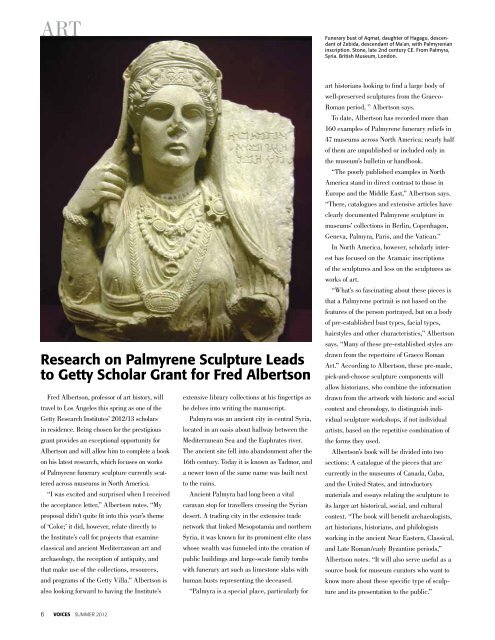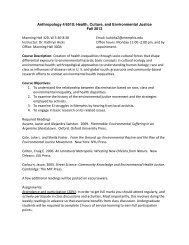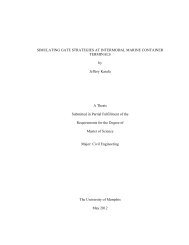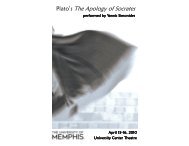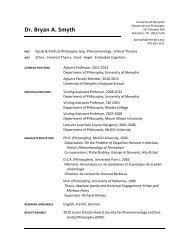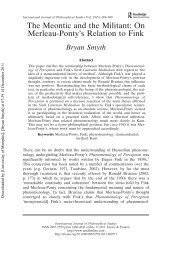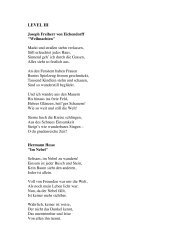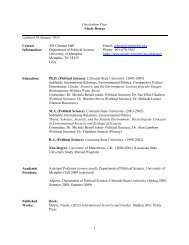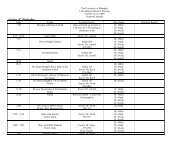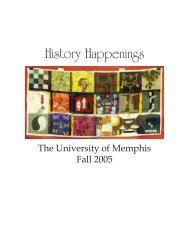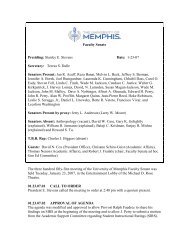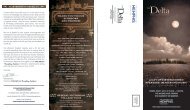Alma Mater - University of Memphis
Alma Mater - University of Memphis
Alma Mater - University of Memphis
Create successful ePaper yourself
Turn your PDF publications into a flip-book with our unique Google optimized e-Paper software.
ART<br />
Research on Palmyrene Sculpture Leads<br />
to Getty Scholar Grant for Fred Albertson<br />
6<br />
Fred Albertson, pr<strong>of</strong>essor <strong>of</strong> art history, will<br />
travel to Los Angeles this spring as one <strong>of</strong> the<br />
Getty Research Institutes’ 2012/13 scholars<br />
in residence. Being chosen for the prestigious<br />
grant provides an exceptional opportunity for<br />
Albertson and will allow him to complete a book<br />
on his latest research, which focuses on works<br />
<strong>of</strong> Palmyrene funerary sculpture currently scat-<br />
tered across museums in North America.<br />
“I was excited and surprised when I received<br />
the acceptance letter,” Albertson notes. “My<br />
proposal didn’t quite fit into this year’s theme<br />
<strong>of</strong> ‘Color;’ it did, however, relate directly to<br />
the Institute’s call for projects that examine<br />
classical and ancient Mediterranean art and<br />
archaeology, the reception <strong>of</strong> antiquity, and<br />
that make use <strong>of</strong> the collections, resources,<br />
and programs <strong>of</strong> the Getty Villa.” Albertson is<br />
also looking forward to having the Institute’s<br />
VOICES SUMMER 2012<br />
extensive library collections at his fingertips as<br />
he delves into writing the manuscript.<br />
Palmyra was an ancient city in central Syria,<br />
located in an oasis about hallway between the<br />
Mediterranean Sea and the Euphrates river.<br />
The ancient site fell into abandonment after the<br />
16th century. Today it is known as Tadmor, and<br />
a newer town <strong>of</strong> the same name was built next<br />
to the ruins.<br />
Ancient Palmyra had long been a vital<br />
caravan stop for travellers crossing the Syrian<br />
desert. A trading city in the extensive trade<br />
network that linked Mesopotamia and northern<br />
Syria, it was known for its prominent elite class<br />
whose wealth was funneled into the creation <strong>of</strong><br />
public buildings and large-scale family tombs<br />
with funerary art such as limestone slabs with<br />
human busts representing the deceased.<br />
“Palmyra is a special place, particularly for<br />
Funerary bust <strong>of</strong> Aqmat, daughter <strong>of</strong> Hagagu, descendant<br />
<strong>of</strong> Zebida, descendant <strong>of</strong> Ma'an, with Palmyrenian<br />
inscription. Stone, late 2nd century CE. From Palmyra,<br />
Syria. British Museum, London.<br />
art historians looking to find a large body <strong>of</strong><br />
well-preserved sculptures from the Graeco-<br />
Roman period, ” Albertson says.<br />
To date, Albertson has recorded more than<br />
160 examples <strong>of</strong> Palmyrene funerary reliefs in<br />
47 museums across North America; nearly half<br />
<strong>of</strong> them are unpublished or included only in<br />
the museum’s bulletin or handbook.<br />
“The poorly published examples in North<br />
America stand in direct contrast to those in<br />
Europe and the Middle East,” Albertson says.<br />
“There, catalogues and extensive articles have<br />
clearly documented Palmyrene sculpture in<br />
museums’ collections in Berlin, Copenhagen,<br />
Geneva, Palmyra, Paris, and the Vatican.”<br />
In North America, however, scholarly inter-<br />
est has focused on the Aramaic inscriptions<br />
<strong>of</strong> the sculptures and less on the sculptures as<br />
works <strong>of</strong> art.<br />
“What’s so fascinating about these pieces is<br />
that a Palmyrene portrait is not based on the<br />
features <strong>of</strong> the person portrayed, but on a body<br />
<strong>of</strong> pre-established bust types, facial types,<br />
hairstyles and other characteristics,” Albertson<br />
says. “Many <strong>of</strong> these pre-established styles are<br />
drawn from the repertoire <strong>of</strong> Graeco Roman<br />
Art.” According to Albertson, these pre-made,<br />
pick-and-choose sculpture components will<br />
allow historians, who combine the information<br />
drawn from the artwork with historic and social<br />
context and chronology, to distinguish indi-<br />
vidual sculpture workshops, if not individual<br />
artists, based on the repetitive combination <strong>of</strong><br />
the forms they used.<br />
Albertson’s book will be divided into two<br />
sections: A catalogue <strong>of</strong> the pieces that are<br />
currently in the museums <strong>of</strong> Canada, Cuba,<br />
and the United States, and introductory<br />
materials and essays relating the sculpture to<br />
its larger art historical, social, and cultural<br />
context. “The book will benefit archaeologists,<br />
art historians, historians, and philologists<br />
working in the ancient Near Eastern, Classical,<br />
and Late Roman/early Byzantine periods,”<br />
Albertson notes. “It will also serve useful as a<br />
source book for museum curators who want to<br />
know more about these specific type <strong>of</strong> sculp-<br />
ture and its presentation to the public.”


